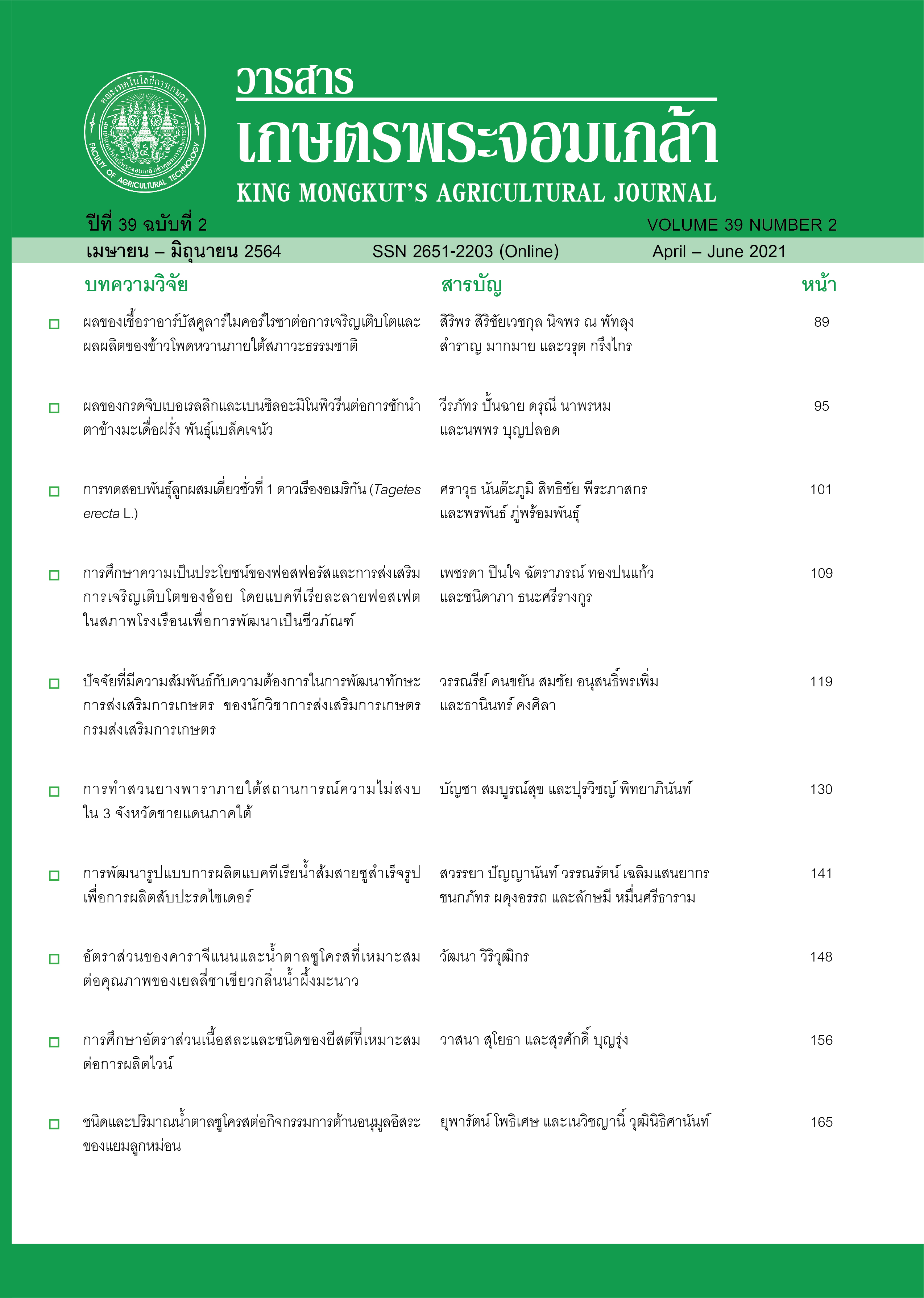Appropriate Carrageenan and Sucrose Ratios on Quality of Green Tea and Jelly with Honey Lemon Flavor
Main Article Content
Abstract
The objective of this research was to develop green tea jelly with honey lemon flavor products.
The optimal ratio of carrageenan and sucrose for gel formation and other characteristics were investigated. Preliminary analysis of the level of phenolic compounds and percentage of inhibition activity according to DPPH assay in green tea revealed 90.36 mg/g gallic acid and 92.11%, respectively. This research consisted in four experiments: 1) carrageenan and sucrose ratio 0.5 : 3.9, 2) carrageenan and sucrose ratio 0.6 : 3.8, 3) carrageenan and sucrose ratio 0.7 : 3.7, and 4) carrageenan and sucrose ratio 0.8 : 3.6. The physical, chemical, and sensory properties of green tea jelly with honey lemon flavor product were evaluated. The physical results indicated that L*, -a*, and b* values were statistically different (P<0.05). In addition, the results showed that sensory evaluation of the carrageenan and sucrose ratio of 0.8 : 3.6 gave the highest liking score, which was a value of 6.80. Reduction in the amount of sucrose cause reduced product acceptance levels. The level of phenolic compounds and percentage of inhibition activity in the experiment 4 were 62.13 mg/g gallic acid and 62.17, respectively.
Article Details
King Mongkut's Agricultural Journal
References
กมลพิพัฒน์ ชนะสิทธิ์, ปรัชญา แพมงคล และศศิธร ป้อมเชียงพิณ. 2559. การพัฒนาผลิตภัณฑ์เยลลี่มะม่วงหาวมะนาวโห่. ใน การประชุมวิชาการมหาวิทยาลัยเทคโนโลยีราชมงคล ครั้งที่ 8. 24-26 สิงหาคม 2559. น. 63-71. กรุงเทพฯ: มหาวิทยาลัยเทคโนโลยีราชมงคลกรุงเทพ.
กุสุมา ทินกร ณ อยุธยา และนัทมน พุฒดวง. 2559. การพัฒนาผลิตภัณฑ์เยลลี่ธัญพืชเพื่อสุขภาพ. เทคโนโลยีอาหาร 11(1): 13-20.
ชรินรัตน์ อุดเมืองคำ. 2552. การพัฒนาผลิตภัณฑ์เยลลี่จากสาหร่ายไก. ศึกษาศาสตรมหาบัณฑิต, สาขาวิชาวิทยาศาสตรศึกษา
คณะวิทยาศาตร์ มหาวิทยาลัยศรีนครินทรวิโรฒ.
ชานนท์ นัยจิตร และอนุรักษ์ เชื้อมั่ง. 2559. การประเมินฤทธิ์ต้านอนมุลูอิสระสารประกอบรวมฟีนอลและนิโคตินของสมุนไพรไทย 15 ชนิด. วิทยาศาสตร์และเทคโนโลยี 24: 351-361.
ดวงกมล ตั้งสถิตพร, ชิดชนก เอมสมร และธันย์ชนก จรสมร. 2556. การใช้ประโยชน์จากแกนสับปะรดและชาภูฟ้าในผลิตภัณฑ์เยลลี่พร้อมดื่ม. วิชาการและวิจัย มทร.พระนคร (พิเศษ): 24-35.
พจนี อุปโภชน์. 2546. การพัฒนาเจลลี่เจลาตินผสมชาเขียว. วิทยาศาสตรมหาบัณฑิต, ภาควิชาพัฒนาผลิตภัณฑ์ คณะอุตสาหกรรมเกษตร มหาวิทยาลัยเกษตรศาสตร์.
ไพโรจน์ วิริยจารี. 2545. การประเมินทางประสาทสัมผัส. เชียงใหม่: ภาควิชาเทคโนโลยีการพัฒนาผลิตภัณฑ์ คณะอุตสาหกรรมเกษตร มหาวิทยาลัยเชียงใหม่.
ไพโรจน์ วิริยจารี. 2555. การออกแบบการทดลอง. พิมพ์ครั้งที่ 2. เชียงใหม่: สาขาวิชาเทคโนโลยีการพัฒนาผลิตภัณฑ์ คณะอุตสาหกรรมเกษตร มหาวิทยาลัยเชียงใหม่.
ภัทราวดี วงษ์วาศ, วิชุดา ตามัย และดำรงศักดิ์ ฤทธิ์งาม. 2560. ทัศนคติและการยอมรับของผู้บริโภคต่อผลิตภัณฑ์ชาเขียวแบบซอง.
แก่นเกษตร 45(1)(พิเศษ): 1459-1463.
วัฒนา วิริวุฒิกร. 2562. ผลของการอบแห้งที่มีต่อคุณภาพการเก็บรักษาผลิตภัณฑ์ชาเขียวผสมกระเจี๊ยบเขียวและมะลิ. วิทยาศาสตร์เกษตร
(1)(พิเศษ): 469-475.
วัฒนา วิริวุฒิกร. 2563. อัตราส่วนที่เหมาะสมของเจลาตินที่มีต่อการผลิตกัมมี่น้ำสับปะรดเสริมเยื่อหุ้มเมล็ดฟักข้าว. วารสารเกษตรพระจอมเกล้า 38(3): 400-407.
สำนักงานมาตรฐานผลิตภัณฑ์ชุมชน. 2547. มาตรฐานผลิตภัณฑ์ชุมชนเยลลี่เหลว เยลลี่อ่อน และเยลลี่แข็ง (มผช 519/2547).
http://app.tisi.go.th/otop/pdf_file/tcps518_ 47.pdf (10 มกราคม 2557).
สุทธิวัฒน์ แซ่ฮ้อ, ณัฐพัฒน์ วัฒนกฤษฎา, ผาณิต ไทยยันโต และเบญจวรรณ ธรรมธนารักษ์. 2554. การพัฒนาผลิตภัณฑ์เยลลี่คาราจีแนนสูตรน้ำผัก. วิทยาศาสตร์เกษตร 42(2)(พิเศษ): 509-512.
สุวรรณา สุภิมารส. 2543. เทคโนโลยีการผลิตลูกกวาดและช็อกโกแลต. กรุงเทพฯ: สำนักพิมพ์แห่งจุฬาลงกรณ์มหาวิทยาลัย.
อรุณ ชาญชัยเชาว์วิวัฒน์, ณัฐดนัย สิงห์คลีวรรณ และสุวินัย เกิดทับทิม. 2560. การสร้างตู้บ่มลูกแป้งและการแปรรูปกัมมี่เยลลี่จากข้าวหมาก
ผสมสมุนไพรเพื่อเป็นขนมเพิ่มคุณค่าทางโภชนาการและใช้เป็นผลิตภัณฑ์ชุมชน. ใน รายงานการวิจัยและการพัฒนาการวิจัยการเกษตร ฉบับสมบูรณ์. มหาวิทยาลัยราชภัฏบ้านสมเด็จเจ้าพระยา.
อินทิรา ลิจันทร์พร, ภูรินทร์ อัครกุลธร, นพรัตน์ ปานสอาด และวียณา สวยทอง. 2558. ปริมาณสารประกอบฟีนอลิกและสารต้านอนุมูลอิสระ
ของคุกกี้เสริมผงใบบัวหลวง. ใน การประชุมวิชาการ “การพัฒนาบัวให้เป็นพืชเศรษฐกิจ ครั้งที่ 12 ปทุมธานี เมืองบัว.
ตุลาคม 2558. น.110-114. พิพิธภัณฑ์บัว, ปทุมธานี: มหาวิทยาลัยเทคโนโลยีราชมงคลธัญบุรี.
AOAC. 2000. Official methods of analysis, 17th ed. USA: The Association of Official Analytical Chemists (AOAC).
Demars, L. L., and Ziegler, G. 1996. Texture and structure of gelatin / HM pectin-based gummy confections. Food Hydrocolloids 15(4): 643-653.
Garcia, T. 2000. Analysis of gelatin-based confections. The Manufacturing Confectioner 80(6): 93-101.
Glicksman, M. 1969. Gum technology in food industry. 1st ed. New York: Academic Press.
Langendorff, V., Cuvelier, G., Launay, B., Michon, C., Parker, A., and Kruif, C. G. D. 1999. Casein micelle/iota carrageenan
in interactions in milk: influence of temperature. Food Hydrocolloids 13(3): 211-218.
Shen, Y., Jin, L., Xiao, P., Lu, Y., and Bao, J. S. 2009. Total phenolics, flavonoids, antioxidant capacity in rice grain and their relations to grain color, size, and weight. Cereal Science 49: 106-111.
Sousa, I. M. N., Matias, E. C., and Laureano, O. 1997. The texture of low calorie grape juice jelly. Zeitschrift fur Lebensmittel-Untersuchung und -Forschung (Germany) 205(2): 140-142.
Uddin, M. B., and Khanom, S. A. A. 1992. Comparative studies on single and mixed-fruit jelly preparation. Nutrition Bangladesh 5(2): 21-26.
Woo, A. 1988. Use of organic acids in confectionery. The Manufacturing Confectioner 78(8): 63-70.
Xu, S. Y., Stanley, D. W., Goff, H. D., Davidson, V. J., and Maguer, M. L. 1992. Hydrocolloid/milk gel formation and properties.
Food Science 57: 96-102.
Zaeoung, S., Plubrukarn, A., and Keawpradub, N. 2005. Cytotoxic and free radical scavenging activities of Zingiberaceous rhizomes. Songklanakarin Journal Science Technology 27: 799-812.


